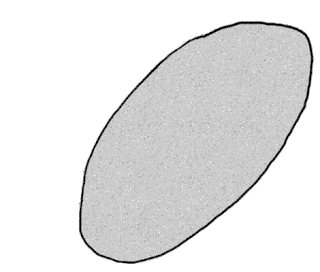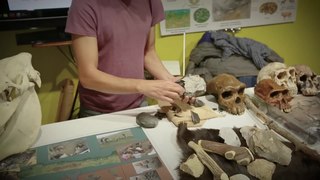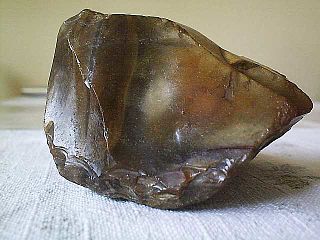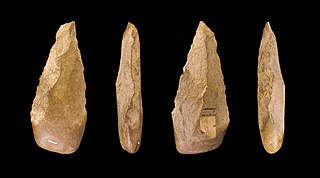
The Stone Age was a broad prehistoric period during which stone was widely used to make stone tools with an edge, a point, or a percussion surface. The period lasted for roughly 3.4 million years and ended between 4,000 BC and 2,000 BC, with the advent of metalworking. It therefore represents nearly 99.3% of human history. Though some simple metalworking of malleable metals, particularly the use of gold and copper for purposes of ornamentation, was known in the Stone Age, it is the melting and smelting of copper that marks the end of the Stone Age. In Western Asia, this occurred by about 3,000 BC, when bronze became widespread. The term Bronze Age is used to describe the period that followed the Stone Age, as well as to describe cultures that had developed techniques and technologies for working copper alloys into tools, supplanting stone in many uses.

In archaeology, a hammerstone is a hard cobble used to strike off lithic flakes from a lump of tool stone during the process of lithic reduction. The hammerstone is a rather universal stone tool which appeared early in most regions of the world including Europe, India and North America. This technology was of major importance to prehistoric cultures before the age of metalworking.

In archaeology, in particular of the Stone Age, lithic reduction is the process of fashioning stones or rocks from their natural state into tools or weapons by removing some parts. It has been intensely studied and many archaeological industries are identified almost entirely by the lithic analysis of the precise style of their tools and the chaîne opératoire of the reduction techniques they used.
A stone tool is, in the most general sense, any tool made either partially or entirely out of stone. Although stone tool-dependent societies and cultures still exist today, most stone tools are associated with prehistoric cultures that have become extinct. Archaeologists often study such prehistoric societies, and refer to the study of stone tools as lithic analysis. Ethnoarchaeology has been a valuable research field in order to further the understanding and cultural implications of stone tool use and manufacture.

A hand axe is a prehistoric stone tool with two faces that is the longest-used tool in human history. It is made from stone, usually flint or chert that has been "reduced" and shaped from a larger piece by knapping, or hitting against another stone. They are characteristic of the lower Acheulean and middle Palaeolithic (Mousterian) periods, roughly 1.6 million years ago to about 100,000 years ago, and used by Homo erectus and other early humans, but rarely by Homo sapiens.

Acheulean, from the French acheuléen after the type site of Saint-Acheul, is an archaeological industry of stone tool manufacture characterized by the distinctive oval and pear-shaped "hand axes" associated with Homo erectus and derived species such as Homo heidelbergensis.

The Oldowan was a widespread stone tool archaeological industry (style) in prehistory. These early tools were simple, usually made with one or a few flakes chipped off with another stone. Oldowan tools were used during the Lower Paleolithic period, 2.9 million years ago up until at least 1.7 million years ago (Ma), by ancient Hominins across much of Africa. This technological industry was followed by the more sophisticated Acheulean industry.

In the archaeology of the Stone Age, an industry or technocomplex is a typological classification of stone tools.

The Clactonian is the name given by archaeologists to an industry of European flint tool manufacture that dates to the early part of the interglacial period known as the Hoxnian, the Mindel-Riss or the Holstein stages. Clactonian tools were made by Homo heidelbergensis.

The Lower Paleolithic is the earliest subdivision of the Paleolithic or Old Stone Age. It spans the time from around 3.3 million years ago when the first evidence for stone tool production and use by hominins appears in the current archaeological record, until around 300,000 years ago, spanning the Oldowan and Acheulean lithics industries.

The Levallois technique is a name given by archaeologists to a distinctive type of stone knapping developed around 250,000 to 300,000 years ago during the Middle Palaeolithic period. It is part of the Mousterian stone tool industry, and was used by the Neanderthals in Europe and by modern humans in other regions such as the Levant.

Archaeologists define a chopper as a pebble tool with an irregular cutting edge formed through the removal of flakes from one side of a stone.

The Tabun Cave is an excavated site located at Nahal Me'arot Nature Reserve, Israel and is one of the Human Evolution sites at Mount Carmel, which were proclaimed as having universal value by UNESCO in 2012.

A ficron handaxe is the name given to a type of prehistoric stone tool biface with long, curved sides and a pointed, well-made tip. They are found in Lower Palaeolithic, Middle Palaeolithic and Acheulean contexts, and are some of the oldest tools ever created by humans. The tool was named by the French archaeologist François Bordes.
In archaeology, a tranchet flake is a characteristic type of flake removed by a flintknapper during lithic reduction. Known as one of the major categories in core-trimming flakes, the making of a tranchet flake involves removing a flake parallel to the final intended cutting edge of the tool which creates a single straight edge as wide as the tool itself. A large flint artifact with a chisel-end, the tranchet flake has a cutting edge that is sharp and straight. The cutting edge is unmodified in most cases; sometimes, it is polished for increased durability and/or sharpness.
The prehistory of the County of Norfolk, England is broken into specific time periods, these being Palaeolithic, Mesolithic and Neolithic.
The prehistory of the Levant includes the various cultural changes that occurred, as revealed by archaeological evidence, prior to recorded traditions in the area of the Levant. Archaeological evidence suggests that Homo sapiens and other hominid species originated in Africa and that one of the routes taken to colonize Eurasia was through the Sinai Peninsula desert and the Levant, which means that this is one of the most occupied locations in the history of the Earth. Not only have many cultures and traditions of humans lived here, but also many species of the genus Homo. In addition, this region is one of the centers for the development of agriculture.
The Soanian culture is a prehistoric technological culture from the Siwalik Hills in the Indian subcontinent. It is named after the Soan Valley in Pakistan. Soanian sites are found along the Siwalik region in present-day India, Nepal and Pakistan. The Soanian culture has been approximated to have taken place during the Middle Pleistocene period or the mid-Holocene epoch (Northgrippian). Debates still goes on today regarding the exact period occupied by the culture due to artefacts often being found in non-datable surface context. This culture was first discovered and named by the anthropology and archaeology team led by Helmut De Terra and Thomas Thomson Paterson. Soanian artifacts were manufactured on quartzite pebbles, cobbles, and occasionally on boulders, all derived from various fluvial sources on the Siwalik landscape. Soanian assemblages generally comprise varieties of choppers, discoids, scrapers, cores, and numerous flake type tools, all occurring in varying typo-technological frequencies at different sites.
Kariandusi prehistoric site is an archaeological site in Kenya. Located on the southeastern edge of the Great Rift Valley and on Lake Elmenteita, Kariandusi is an African Early Stone Age site dating to approximately 1 million years ago.

Naama Goren-Inbar is an Israeli archaeologist and paleoanthropologist and professor emeritus at the Institute of Archaeology, The Hebrew University of Jerusalem. Goren-Inbar excavated many important prehistoric sites in Israel including the Acheulian site of Gesher Benot Ya’aqov. In 2014, she received the EMET Prize in Humanities and Judaism, and in 2016 was elected to the Israel Academy of Sciences.















